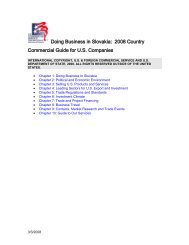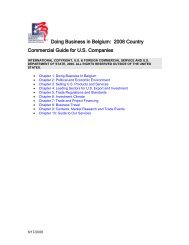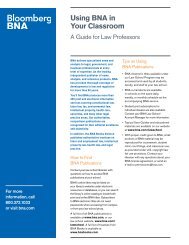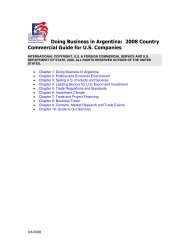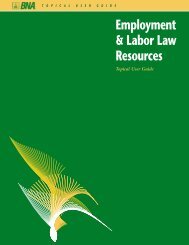Doing Business In (Insert Country Name Here) - BNA
Doing Business In (Insert Country Name Here) - BNA
Doing Business In (Insert Country Name Here) - BNA
Create successful ePaper yourself
Turn your PDF publications into a flip-book with our unique Google optimized e-Paper software.
To promote market acceptance of the final product, there are a number of voluntary<br />
conformity assessment programs. CEN’s certification systems are the Keymark, the<br />
CENCER mark, and the European Standard Agreement Group. CENELEC has its own<br />
initiative. ETSI does not offer conformity assessment services.<br />
Product Certification Return to top<br />
To sell products on the EU market of 27 Member States as well as Norway,<br />
Liechtenstein and Iceland, U.S. exporters are required to apply CE marking whenever<br />
their product is covered by specific product legislation. CE marking product legislation<br />
offers manufacturers a number of choices and requires decisions to determine which<br />
safety/health concerns need to be addressed, which conformity assessment module is<br />
best suited to the manufacturing process, and whether or not to use EU-wide<br />
harmonized standards. There is no easy way for U.S. exporters to understand and go<br />
through the process of CE marking, but hopefully this section provides some background<br />
and clarification.<br />
Products manufactured to standards adopted by CEN, CENELEC and ETSI, and<br />
published in the Official Journal as harmonized standards, are presumed to conform to<br />
the requirements of EU Directives. The manufacturer then applies the CE marking and<br />
issues a declaration of conformity. With these, the product will be allowed to circulate<br />
freely within the EU. A manufacturer can choose not to use the harmonized EU<br />
standards, but then must demonstrate that the product meets the essential safety and<br />
performance requirements. Trade barriers occur when design, rather than performance,<br />
standards are developed by the relevant European standardization organization, and<br />
when U.S. companies do not have access to the standardization process through a<br />
European presence.<br />
The CE marking addresses itself primarily to the national control authorities of the<br />
Member States, and its use simplifies the task of essential market surveillance of<br />
regulated products. Although CE marking is intended primarily for inspection purposes<br />
by Member State inspectors, the consumer may well perceive it as a quality mark.<br />
The CE marking is not intended to include detailed technical information on the product,<br />
but there must be enough information to enable the inspector to trace the product back<br />
to the manufacturer or the authorized representative established in the EU. This detailed<br />
information should not appear next to the CE marking, but rather on the declaration of<br />
conformity, the certificate of conformity (which the manufacturer or authorized agent<br />
must be able to provide at any time, together with the product's technical file), or the<br />
documents accompanying the product.<br />
French Certification body “AFNOR CERTIFICATION”:<br />
NF network<br />
To expand its activities and thus improve recognition of its labels, AFNOR<br />
CERTIFICATION relies on the strength and expertise of a network of impartial and<br />
competent bodies whose scientific knowledge and technical know-how ensure the value<br />
and credibility of its certifications.<br />
2/15/2008 <strong>Country</strong> Commercial Guide for France 88<br />
INTERNATIONAL COPYRIGHT, U.S. & FOREIGN COMMERCIAL SERVICE AND U.S. DEPARTMENT OF STATE,<br />
© 2007. ALL RIGHTS RESERVED OUTSIDE OF THE UNITED STATES.



